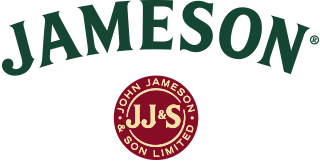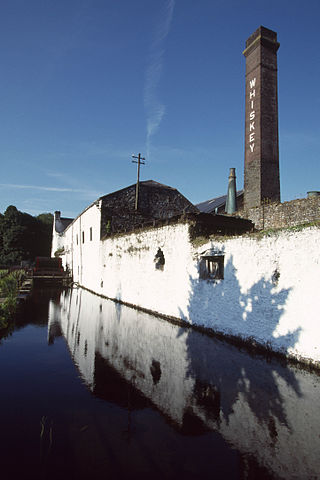Related Research Articles

Irish whiskey is whiskey made on the island of Ireland. The word 'whiskey' comes from the Irish uisce beatha, meaning water of life. Irish whiskey was once the most popular spirit in the world, though a long period of decline from the late 19th century onwards greatly damaged the industry, so much so that although Ireland boasted at least 28 distilleries in the 1890s, by 1966 this number had fallen to just two, and by 1972 the remaining distilleries, Bushmills Distillery and Old Midleton Distillery, were owned by just one company, Irish Distillers.

Jameson is a blended Irish whiskey produced by the Irish Distillers subsidiary of Pernod Ricard. Originally one of the six main Dublin whiskeys at the Jameson Distillery Bow St., Jameson is now distilled at the New Midleton Distillery in County Cork. It is by far the best-selling Irish whiskey in the world; in 2019, annual sales passed 8 million cases. It has been sold internationally since the early 19th century, and is available to buy in over 130 countries.

Paddy is a brand of blended Irish whiskey produced by the Sazerac Company. As of 2016, Paddy is the fourth largest-selling Irish whiskey in the World.

Kilbeggan Distillery is an Irish whiskey distillery situated on the River Brosna in Kilbeggan, County Westmeath, Ireland. It is owned by Suntory Global Spirits, an subsidiary of Suntory Holdings of Osaka, Japan. A small pot still distillery, the licence to distil dates to 1757, a copy of which can be seen in the distillery.
Aeneas Coffey (1780–1839) was an Irish inventor and distiller.

Powers is a brand of Irish whiskey produced by the Irish Distillers subsidiary of Pernod Ricard. Historically a single pot still whiskey, the flagship Powers Gold Label brand was the first Irish whiskey ever to be bottled. Powers Gold Label was the best-selling whiskey in Ireland.

Marlfield is a village three kilometres west of Clonmel, County Tipperary, Ireland. It is within the townlands of Marlfield and Inishlounaght. It replaced an older settlement named Abbey, which had developed near the 12th century Cistercian community of Inislounaght Abbey.
The Jameson Experience, Midleton, is an Irish whiskey museum and visitor centre located in the Old Midleton Distillery in Midleton, County Cork, Ireland. Set over 15 acres, since opening as a visitor's centre in 1992, the old distillery has received approximately 100,000 guests per year, receiving 125,000 in 2015.
Allman's Bandon Distillery was an Irish whiskey distillery which was established in 1826 in Bandon, County Cork, Ireland. The distillery closed in 1929 following financial difficulties. However, agents for the company trading under the name Allman, Dowden & Co., may have continued to sell off the existing stock which had built up in bonded warehouses, in both cask and bottled form, until 1939.
The Thomas Street Distillery was an Irish whiskey distillery located in Dublin, Ireland. At its peak, it was Dublin's largest and most productive distillery and with an output of over 2 million gallons per annum, twice that of John Jameson's acclaimed nearby Bow Street distillery. Alfred Barnard, a British author who visited most of the distilleries in the then United Kingdom of Great Britain and Ireland in the late 1880s, wrote that, at the time of his visit, the Thomas Street Distillery may have been the largest whiskey distillery in the world and probably had the highest output of any whiskey distillery in the British Isles. However, the distillery later entered into financial difficulties, and closed in 1926. Although most of the distillery buildings were demolished following its closure, a few were incorporated into the Guinness St. James's Gate Brewery and are still extant.

The Marrowbone Lane Distillery was an Irish whiskey distillery located on Marrowbone Lane, in Dublin, Ireland. One of the "big four" historical Dublin whiskey firms, it was run by William Jameson, a member of the Jameson whiskey dynasty. However, the whiskey now known as Jameson Irish Whiskey was not produced at this distillery, but at the separate enterprise run by John Jameson at the nearby Bow Street Distillery. The distillery closed in 1923 following financial difficulties.
The North Mall Distillery was an Irish whiskey distillery located in Cork City, Ireland. In its day one of the most famous distilleries in Ireland, the distillery was destroyed by a fire in 1920. Distilling operations never resumed at the North Mall after the fire, and it was later converted into a bottling and storage facility which was used by Irish Distillers until 2007, at which point operations were transferred to Irish Distillers' other bottling facilities in Dublin. In the mid-2000s, much of the site was jointly acquired by University College Cork and Mercy University Hospital, and has since been redeveloped.

The Dundalk Distillery was an Irish whiskey distillery that operated in Dundalk, County Louth, Ireland between 1708 and 1926. It is thought to have been one of the old registered distilleries in Ireland. Two of the distillery buildings, the grain store and maltings, still exist and now house the County Museum and Dundalk Library.

Daly's Distillery was an Irish whiskey distillery which operated in Cork City, Ireland from around 1820 to 1869. In 1867, the distillery was purchased by the Cork Distilleries Company (CDC), in an amalgamation of five cork distilleries. Two years later, in 1869, as the smallest CDC distillery, Daly's Distillery ceased operations. In the years that followed its closure, some of the buildings became part of Shaw's Flour Mill, and Murphy's Brewery, with others continuing to be used as warehouses by Cork Distilleries Company for several years.
The Green Distillery was an Irish whiskey distillery which was established in Cork City, Ireland in 1796. In 1867, the distillery was purchased by the Cork Distilleries Company (CDC), in an amalgamation of five Cork distilleries. Production of whiskey at the distillery likely ceased soon afters its acquisition by the CDC. However, the distillery is known to have remained in use a bonded store by the Cork Distilleries Company for several years thereafter. In the mid-twentieth century, the distillery resumed operations as a gin distillery for a period of time, however, it has since been almost completely demolished.
The Old Tullamore Distillery was an Irish whiskey distillery which was established in Tullamore, County Offaly, Ireland, in 1829. The original home of Tullamore Dew Irish whiskey, the distillery closed in 1954, having endured financial difficulties for many years, like many Irish whiskey distilleries of the early 20th century.

The Dublin Whiskey Distillery Company Jones Road Distillery also known as the D.W.D. Distillery, Jones Road, or just Jones Road Distillery, was one of the six great Irish whiskey distilleries of Dublin city visited and documented by Alfred Barnard in his seminal 1887 publication "The Whisky Distilleries of the United Kingdom". It was located on the north side of the city on the banks of the river Tolka, approximately a mile north of the city centre. The distillery was built by the Dublin Whiskey Distillery Company Ltd and the Irish whiskey produced sold around the world under the brand name D.W.D.

Bishop's Water Distillery was an Irish whiskey distillery which operated in Wexford, Ireland between 1827 and 1914. The distillery was named for a stream which ran along the back of the distillery, the Bishop's Water, said to possess "various occult properties derived from the blessings of the sainted Bishop of Ferns".

Nun's Island Distillery was an Irish whiskey distillery which operated in Galway, Ireland, from at least 1815, and possibly as early as the late 1700s, until circa 1908.
Hackett's Distillery was an Irish whiskey distillery which operated in Midleton, County Cork, Ireland between 1824 and circa 1845.
References
- ↑ "A Tale Of Marlfield - Card Playing". The Waterford News. 6 September 1867.
- 1 2 "Marlfield Distillery". Waterford News. 1 August 1856.
- 1 2 3 "Stein Tree Ancestry Site". MyHeritage.com. Retrieved 17 February 2018.
- 1 2 3 4 "Marlfield Distillery". Dublin Evening Mail. 14 November 1856.
- 1 2 "Marlfield Local Area Plan (LAP) 2006" (PDF). Tipperaryinfo.ie. Retrieved 17 February 2018.
- ↑ "Deaths". Dublin Monitor. 4 December 1838.
- ↑ "Marriages". Newry Telegraph. 28 July 1838.
- ↑ The First Ten Reports of the Commissioner of Excise Inquiry. HMSO. 1835.
- ↑ Morewood, Samuel (1838). A philosophical and statistical history...of inebriating liquors... W. Curry, jun. and company.
- ↑ Great Britain. Parliament. House of Commons (1818). Parliamentary papers. HMSO.
- ↑ Great Britain. Parliament. House of Commons (1827). Accounts and Papers Four Volumes -(1.)- Relating to Assessed Taxes; Stamps; Rates of Duties; Customs and Excise; Beer, Hops, and Malt; Spirits; The Distilleries. HMSO.
- ↑ "Provincial Intelligence". Dublin Morning Register. 10 October 1834.
- ↑ "Seed Barley". Tipperary Free Press. 7 April 1849.
- ↑ "Clonmel Markets". Tipperary Free Press. 26 November 1836.
- 1 2 Townsend, Brian (1997–1999). The Lost Distilleries of Ireland. Glasgow: Neil Wilson Publishing. ISBN 9781897784877.
- ↑ "County Tipperary". Dublin Evening Post. 29 October 1846.
- ↑ "Henry Marsh Septimus Jameson". FamousJamesons.com. Retrieved 18 February 2018.
- ↑ Phipps, William Pownoll (1894). The Life of Colonel Pownoll Phipps. London: Richard Bentley & Son. p. 175.
- ↑ "Commercial Intelligence". The Cork Daily Reporter. 5 August 1856.
- ↑ "From our Clonmel Correspondent". Limerick Reporter. 19 December 1856.
- ↑ "Gleamings from our Exchanges". Waterford Chronicle. 20 December 1856.
- ↑ "Sale of Old Whiskey". Waterford Mail. 20 August 1869.
- ↑ "Unreserved Auction". Cork Examiner. 18 October 1864.